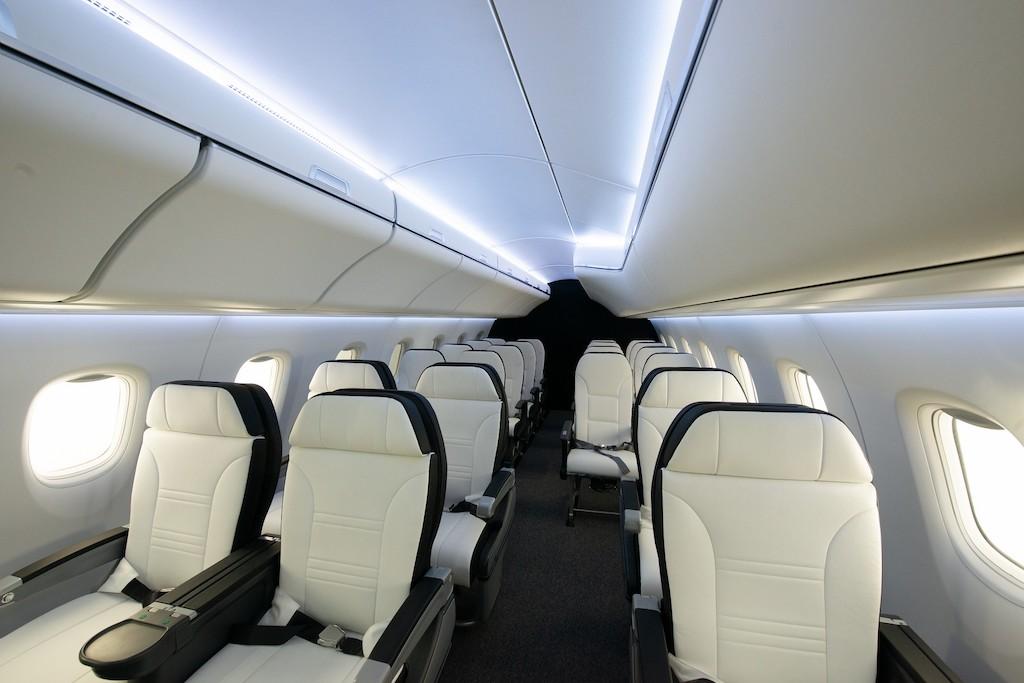
There’s a well-known international supermarket chain which has a slogan saying, “Every little helps!” That’s certainly an epithet which can be ascribed to the efforts by aircraft design engineers as they aim to make their products lighter, more comfortable, more efficient and safer – or any combination of those which has no deleterious effect on the last of them.
When it comes to cabin interiors, making seats lighter and more comfortable is an obvious target, but even the little things, like a better reading light above your seat, can be advantageous.
The two major aircraft families in the crossover narrowbody jets category – the Airbus A220 pairing and Embraer E-Jets E2 trio – have some of the latest interior developments on the market. The former came from a complete clean sheet design, while the E2 maintained the interior cross-section from the first generation, but had a new design.
The effect of new modern lights on an airline’s bottom line comes from the lower power they use. Less power being pulled from means less fuel being burnt and fewer emissions, both attributes which lower costs.
Both aircraft families have a number of providers for their lighting systems, all responding to the OEMs’ requirements. Simon Lesage, product manager at Astronics, which has lighting products on the E2 family, reports that after more than 50 years of recognised presence with its OEM partners, the company has spent the past three years looking at a more ‘holistic’ approach to its cabin lighting offering in this sector. “We are bringing together interior and exterior lighting capabilities for utility and safety functions with a new system designed to meet new passenger comfort needs,” he remarks.
“It is through this paradigm that we wanted to design an intelligent and versatile system mixing wash lighting, flexible accent lighting and independent power and control system already tested and selected by leading OEMs,” Lesage adds. “The main challenge was to adapt to the existing system by bringing novelty to a very mature market, this was notably pushed by deep discussions with OEM experts on the need to reduce the weight and consumption of existing systems, looking at the aviation industry’s ambitions to reduce its carbon footprint.”
Safran Cabin has lighting systems on all the crossover jet models from the two airframers, notes Beth DeYoung, the company’s vice-president of marketing and strategy. “We provide LED (light emitting diode) lighting solutions for the A220 and the E2 families, and for both aircraft the OEMs converted the aircraft to an LED lighting specification. Previous aircraft models primarily utilised incandescent and halogen lighting that requires different lighting control and uses more power on the aircraft,” explains DeYoung.
While the OEMs set out what they want for their aircraft, the suppliers decided on the technologies which would lower the weight and/or power usage of these systems – from the full cabin lighting including sidewalls to individual reading lights and signage lights in PSUs, to other lights such as exit signs.
“In compliance with the LED lighting specification, Safran Cabin designed and produced lighting that is installed directly into the aircraft or into monuments on the aircraft. A full range of LED lighting solutions includes lighting controls, signs, PSUs, reading lights, and cabin illumination that on the A220 takes full advantage of the flexibility of LEDs enabling colour variation and mood lighting to enhance passenger comfort and airline branding,” De Young adds.
“LED technology reduces by an order of magnitude the required power, space and weight of the lighting and lighting controllers on the aircraft in comparison with the older technologies, with the added benefit of a much longer useful life and lower maintenance costs. For example, no bulb replacements are required,” the Safran VP elaborates.
According to Lesage, Astronics made the choice to invest in different technologies such as proprietary LEDs coupled with power management dedicated to the company’s products to optimise their power consumption. “This has been proven useful in the past, as we have been able to adapt the power and electrical consumption budget allocated to our systems according to our customers’ requirements,” he comments.
“The main advantage of using these LEDs is that we can technically control our value chain from end to end,” he continues. “This is including aging management to ensure the longest possible operation and easy maintenance while ensuring the highest quality of CRI (colour rendering index). The result makes us able to provide a lighting quality notably capable to address human centric features such as jetlag reduction.
“Astronics has also worked on the choice of materials, integrating eco-design as a guideline to reduce as much as possible the weight impact at installation. By doing so, we obtained a 15% reduction on the main product’s weight compared to legacy ones through this long-term effort,” Lesage confirms.
Better light quality, lower power usage and maintenance costs, the manufacturers of these lighting system have given crossover jets some key advantages as the aircraft begin to pick up further orders and expand the market for which they were designed.





